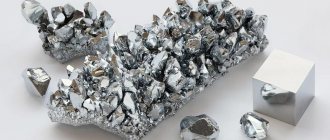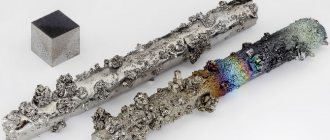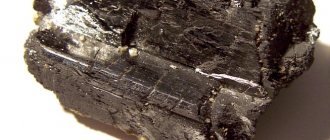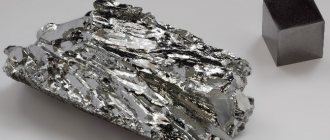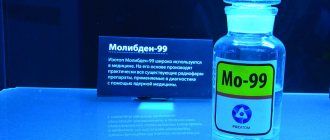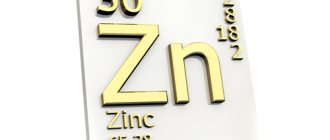What is considered a refractory metal?
The sign by which a metal is classified into a group is indicated by its name.
Refractory metals are chemical elements with a melting point higher than most others:
- In the classical sense, this is more than 2200°C. Five metals have this property.
- However, the term “refractory” is also used in relation to metals with a melting point higher than iron, i.e. from 1850°C. According to this parameter, nine more elements are refractory metals.
Thus, the list of refractory elements includes 14 positions.
produces ingots from expensive metals in the form of chocolate bars
is an organization in Switzerland that has taken a very creative approach to the concept of bullion.
When they say the phrase “gold bars,” people always imagine beautiful shiny bricks stacked on top of each other in a pyramid. But the company decided to destroy this idea. They make gold, silver, platinum and palladium bars in the form of chocolate bars. This was a wonderful gift idea.
Such an ingot can be broken into several small pieces (about 1 gram) and given as a gift to loved ones. Another use case is to pay for purchases in stores that accept this type of payment, of course.
Physico-chemical characteristics
The main characteristic of the group - refractoriness - is provided by the structure of the atoms. The electrons are located so close that breaking the interatomic bonds requires temperatures of up to two thousand degrees.
The second common feature is the slowness of creep deformation. For them to begin to “spread,” heating of 1500+°C is required. Unlike low-melting metals, which spread at a couple of hundred degrees.
However, most of the properties of refractory metals (density, hardness, compression resistance) vary due to belonging to different groups and differences in the structure of the crystal lattice.
More similarities in chemical properties:
- The ease of formation of compounds with other elements, which makes it impossible to detect refractory materials in their pure form.
- When exposed to air, they are covered with a protective film. Speed is determined by temperature.
- When heated or interacting with gases (nitrogen, hydrogen, carbon), the original properties are lost, corrosion develops, and fragility appears.
- Resistance to acids.
Given these characteristics, the elements are worked in a vacuum. The most common example is the tungsten filament inside a household light bulb.
Records for inorganic substances
The strongest stable oxidizing agent
, is a complex of krypton difluoride and antimony pentafluoride. Due to its strong oxidizing effect (oxidizes all elements to higher oxidation states, including oxygen and nitrogen in the air), it is very difficult for it to measure the electrode potential. The only solvent that reacts with it slowly enough is anhydrous hydrogen fluoride.
The densest substance
, is osmium. Its density is 22.5 g/cm3.
The lightest metal
- this is lithium. Its density is 0.543 g/cm3.
The most expensive metal
- this is Californian. Its current cost is $6,500,000 per gram.
Receiving technology
The source of most refractory materials is ore.
The process is traditional:
- Impurities are removed from it.
- Refined (restores the desired element). The recovery method depends on the required degree of metal purity. Therefore, arc-shaped, electron beam or plasma melting is used.
- Plasma produces the best product. It comes in the form of small granules, powder or blanks (wire, foil, ingots, fittings, rolled products).
The melting technology is specific, so special enterprises deal with such raw materials. There were only two of them in the USSR.
Processing of refractory metals is possible only by powder metallurgy methods.
Niobium and its alloys
Nb, or niobium, is a silvery-white shiny metal under normal conditions. It is also refractory, since the temperature of transition to the liquid state for it is 2477 °C. It is this quality, as well as the combination of low chemical activity and superconductivity, that allows niobium to become increasingly popular in human practice every year. Today this metal is used in industries such as:
- rocket science;
- aviation and space industry;
- nuclear power;
- chemical apparatus engineering;
- radio engineering.
This metal retains its physical properties even at very low temperatures. Products based on it are characterized by corrosion resistance, heat resistance, strength, and excellent conductivity.
This metal is added to aluminum materials to improve chemical resistance. Cathodes and anodes are made from it, and non-ferrous alloys are alloyed with it. Even coins in some countries are made with niobium content.
Areas of application
The use of refractory metals is not limited to household light bulbs.
Their properties ensure use by all sectors of the industrial complex, military-industrial complex, and in everyday life:
- Metallurgy. Ligature component for alloys.
- Shipbuilding, aviation, space construction . Engine parts.
- Nuclear sector . Material of reactor parts.
- Khimprom. Catalyst, light source.
- Electronics. Capacitors.
The material is popular as a base for heat-resistant, highly resistant structures (refractories) for these industries. Especially if parts of a complex configuration are required.
The cultivation of rubies is special. To do this, microdoses of chromium are added to the colorless crystal.
Alloys are almost always used. For example, a molybdenum-tantalum-tungsten composition is in demand among nuclear scientists and spacecraft builders. It does not deform at temperatures of about 4000°C, is elastic, plastic, and resistant to rust.
Where is tungsten used?
Tungsten compounds are widely used. They are used in the engineering and mining industries, for drilling wells. Due to its high strength and hardness, this metal is used to make parts of aircraft engines, filaments, artillery shells, high-speed gyroscope rotors, bullets, etc. Tungsten is also successfully used as an electrode in argon-arc welding. Such industries cannot do without tungsten compounds - textile, paint and varnish.
Classification
Depending on the melting point, refractory metals are assigned to the main or additional group.
Main group
This segment includes five positions: tungsten, niobium, tantalum, molybdenum, rhenium.
Melts at 2200°C+. Properties of the fourth group of elements
| Name | Niobium | Molybdenum | Tantalum | Tungsten | Rhenium |
| Melting temperature | 2750 K (2477 °C) | 2896 K (2623 °C) | 3290 K (3017 °C) | 3695 K (3422 °C) | 3459 K (3186 °C) |
| Boiling temperature | 5017 K (4744 °C) | 4912 K (4639 °C) | 5731 K (5458 °C) | 5828 K (5555 °C) | 5869 K (5596 °C) |
| Density | 8.57 g cm³ | 10.28 g cm³ | 16.69 g cm³ | 19.25 g cm³ | 21.02 g cm³ |
| Young's modulus | 105 GPa | 329 GPa | 186 GPa | 411 GPa | 463 GPa |
| Vickers hardness | 1320 MPa | 1530 MPa | 873 MPa | 3430 MPa | 2450 MPa |
Molybdenum
The most popular of the refractory elements.
The number one area of use is metallurgy:
- Molybdenum is used to “strengthen” steel to produce a hard alloy.
- Together with stainless steel, it is used as a material for the infrastructure of pipelines, car parts, and other mechanical engineering products.
- Due to its melting point, wear resistance, and low abrasion, it is used as an alloying additive.
Molybdenum requires a couple of percent of alloys in the composition for the properties of the alloy to change.
For example, half a percent titanium plus 0.08% zirconium creates a molybdenum alloy that does not lose strength up to 1060°C.
Extraordinary friction parameters have led to the use of molybdenum as a long-lasting lubricant with high efficiency.
The material is indispensable for mercury relays, since an amalgam with this metal is not formed by mercury.
Tungsten
Opened at the end of the 18th century. The hardest and most refractory (3422°C) metal.
Refractory durable metal, light gray in color - tungsten
Together with copper and iron, it is used as the basis (up to 80%) of alloys with rhenium, thorium, and nickel. Such additives increase density, rust resistance threshold, and reliability.
It is in demand as a material for power supply systems, instruments, ammunition, and nuclear missile warheads. Nickel alloys are valued by golf fans as club materials.
Tungsten ingots
Tungsten and its alloys are in demand where increased density is needed at extreme temperatures.
Tantalum
The most resistant to acids and corrosion from the segment of refractory metals.
Heavy, hard metal of gray color – tantalum
Therefore, it is used in capacitors of smartphones, tablets, and other gadgets.
Compatible with biological organisms (does not change under the influence of natural acids). Because of this, it is used in medicine.
In nature, niobium and tantalum are neighbors. It is no coincidence that they are named after father and daughter – Tantalus and Niobe, characters from ancient Greek myths.
Niobium
Metal with unusual characteristics:
- The lightest (low density) in the segment.
- It is unique due to its ability to change the coefficient of hardness and elasticity depending on the degree of annealing.
- Most common in superconducting alloys.
It is used as a material for capacitors, gas turbines, rockets, and aircraft. As well as an element of nuclear reactors and lamps of electronic devices.
Together with hafnium and titanium, it is a material for spacecraft engines (for example, the American Apollo).
How is tungsten obtained?
Pure tungsten does not occur in nature. It is part of rocks in the form of trioxide, as well as wolframites of iron, manganese and calcium, less often copper or lead. According to scientists, the tungsten content in the earth's crust averages 1.3 grams per ton. This is a rather rare element compared to other types of metals. The tungsten content in ore after mining usually does not exceed 2%. Therefore, the extracted raw materials are sent to processing plants, where the mass fraction of metal is brought to 55-60% using magnetic or electrostatic separation.
The process of its production is divided into technological stages. In the first stage, pure trioxide is isolated from the mined ore. For this purpose, the thermal decomposition method is used. At temperatures from 500 to 800 degrees Celsius, all excess elements melt, and refractory tungsten in the form of oxide can be easily collected from the melt. The output is raw material with a hexavalent tungsten oxide content of 99%.
The resulting compound is thoroughly crushed and a reduction reaction is carried out in the presence of hydrogen at a temperature of 700 degrees Celsius. This allows you to isolate pure metal in powder form. Next, it is pressed under high pressure and sintered in a hydrogen environment at temperatures of 1200-1300 degrees Celsius. After this, the resulting mass is sent to an electric melting furnace, where, under the influence of current, it is heated to a temperature of over 3000 degrees. This is how tungsten turns into a molten state.
For final purification from impurities and obtaining a single-crystal structural lattice, the zone melting method is used. It implies that at a certain point in time only a certain zone of the total area of the metal is molten. Gradually moving, this zone redistributes impurities, as a result of which they ultimately accumulate in one place and can be easily removed from the alloy structure.
Finished tungsten arrives at the warehouse in the form of bars or ingots, intended for the subsequent production of the desired products. To obtain tungsten alloys, all constituent elements are crushed and mixed in powder form in the required proportions. Next, sintering and melting are carried out in an electric furnace.
Tin (231°C)
Features of rare metals and alloys
The chemical element, which occupies the fiftieth place in the periodic table, has been known to mankind since ancient times. The first drops of tin (Latin name Stannum) were noticed by primitive people in their fires 4 thousand years BC. No wonder - after all, tin melts at a temperature of only 231°C. At the same time, the tree is just beginning to char and burn timidly.
After hardening, the “tears” with which the beautiful heavy cassiderite stone cried in the fire retained the shape in which they happened to freeze. This is how the first metal kitchen utensils appeared.
When it was possible to melt red copper from green malachite, it turned out that the mixture of copper and tin was much stronger than any of the metals separately. It was then that civilization began to develop rapidly. Weapons, armor, dishes, tools - everything was made of durable and beautiful bronze.
Molybdenum
If you find out which metal is the most refractory, then, in addition to the indicated tungsten, you can also name molybdenum. Its melting point is 2623 °C. At the same time, it is quite hard, plastic and amenable to processing.
It is mainly used not in its pure form, but as an integral component of alloys. They, thanks to the presence of molybdenum, are significantly strengthened in wear resistance, heat resistance and anti-corrosion.
Some molybdenum compounds are used as technical lubricants. This metal is also an alloying material that simultaneously affects both strength and corrosion resistance, which is very rare.
Concept of temperature scale
Some non-metallic objects also have similar properties. The most common is water. A temperature scale was developed regarding the properties of the liquid that occupies a dominant position on Earth. The reference points are the temperature of changes in the aggregative states of water:
- Transformations from liquid to solid and vice versa are taken to be zero degrees.
- Boiling (vapor formation inside a liquid) at normal atmospheric pressure (760 mm Hg) is taken to be 100 ⁰C.
Attention! In addition to the Celsius scale, in practice temperature is measured in degrees Fahrenheit and on the absolute Kelvin scale. But when studying the properties of metal objects, other scales are used quite rarely.
Aluminum production
The main raw material for aluminum production is bauxite containing 32-60% alumina Al2O3. The most important aluminum ores also include alunite and nepheline. Russia has significant reserves of aluminum ores. In addition to bauxite, large deposits of which are located in the Urals and Bashkiria, a rich source of aluminum is nepheline, mined on the Kola Peninsula. A lot of aluminum is also found in deposits in Siberia.
Aluminum is produced from aluminum oxide Al2O3 by the electrolytic method. The aluminum oxide used for this must be sufficiently pure, since impurities are difficult to remove from smelted aluminum. Purified Al2O3 is obtained by processing natural bauxite.
The main starting material for aluminum production is aluminum oxide. It does not conduct electricity and has a very high melting point (about 2050oC), so it requires too much energy.
It is necessary to reduce the melting point of aluminum oxide to at least 1000oC. This method was simultaneously found by the Frenchman P. Heroux and the American C. Hall. They discovered that alumina dissolves well in molten cryolite, a mineral with the composition AlF3.3NaF. This melt is subjected to electrolysis at a temperature of only about 950oC in aluminum production. Reserves of cryolite in nature are insignificant, so synthetic cryolite was created, which significantly reduced the cost of aluminum production.
A molten mixture of Na3 [AlF6] cryolite and aluminum oxide is subjected to hydrolysis. A mixture containing about 10 weight percent Al2O3 melts at 960oC and has electrical conductivity, density and viscosity that are most favorable for the process. To further improve these characteristics, AlF3, CaF2 and MgF2 additives are added to the mixture. Thanks to this, electrolysis is possible at 950oC.
The electrolyser for aluminum smelting is an iron casing lined with refractory bricks on the inside. Its bottom (under), assembled from blocks of compressed coal, serves as a cathode. Anodes (one or more) are located on top: these are aluminum frames filled with coal briquettes. In modern plants, electrolysers are installed in series; each series consists of 150 or more electrolysers.
During electrolysis, aluminum is released at the cathode and oxygen at the anode. Aluminum, which has a higher density than the original melt, is collected at the bottom of the electrolyzer, from where it is periodically released. As the metal is released, new portions of aluminum oxide are added to the melt. The oxygen released during electrolysis interacts with the carbon of the anode, which burns out, forming CO and CO2.
The first aluminum smelter in Russia was built in 1932 in Volkhov.
